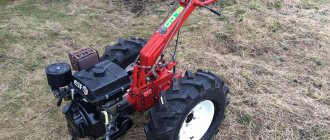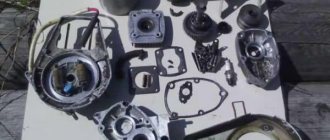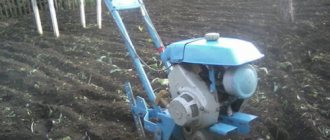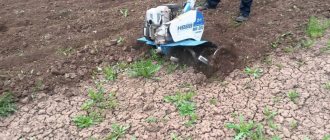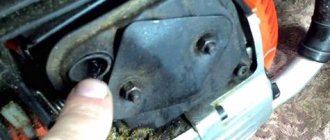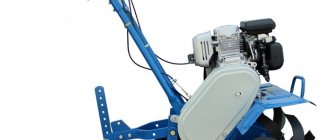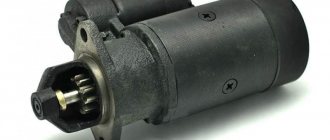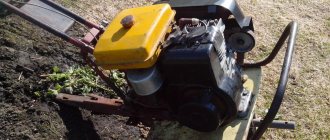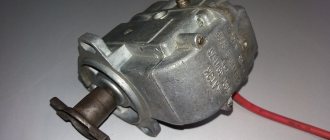Dear summer residents and gardeners!
We continue to expand the information section of our website. We present to your attention a brief instruction “Possible malfunctions of the Krot MK-1A-01TS motor-cultivator, causes and solutions.” This section will be especially useful to those of you who bought your “Mole” motor-cultivator not from our store, but from private individuals without an instruction manual included.
Auto mechanic, specializes in agricultural equipment
When cultivating land plots, summer residents are increasingly using small-sized agricultural equipment. This includes walk-behind tractors from various manufacturers, the use of which allows you to quickly and effortlessly cultivate the soil in your garden. Among domestic models, the Mole motor-cultivator is in demand. It copes with all the tasks assigned to it, and the price is low, and almost every summer resident can buy it. However, any equipment tends to break down, and the Mole cultivator is no exception. Below we will look at the common causes of breakdowns and figure out what to do if the equipment does not start.
Malfunctions and their elimination in the Mole motor-cultivator
Every piece of equipment that is used to perform a large volume of work breaks down over time. There can be many reasons for this, for example:
- The working life of the part is nearing its end.
- Defective components installed on equipment during the assembly process.
- Incorrect operation.
- Late and superficial maintenance.
- Excessive loads on the walk-behind tractor, as a result of which parts fail faster.
- Error in assembly at the factory.
All these reasons lead to the fact that technology can:
- Wedge.
- Refuse to start.
- No spark when turned on.
- Gearbox failure.
- Failure of the walk-behind tractor belt.
In this video we will look at how to repair a motor cultivator:
All these malfunctions make further operation of the equipment impossible, and not everyone knows how to fix them. Let's look at each problem situation in more detail and decide on the algorithm of actions if it arises.
Does not start
If the walk-behind tractor refuses to start, do the following:
- Check the condition of the drain hole located in the fuel tank. If it is clogged, the motor will not work.
- Inspect the air filter. If it becomes clogged and fails, replace it with a new one.
- The spark plug may be faulty, preventing the engine from starting. There are many reasons for the problem, and we will consider them separately.
- If a flame bursts out of the muffler while working on equipment, this is bad. This may cause the flywheel key to become deformed and you will have to replace it.
- Check the condition of the cylinder seals.
- Make sure the gasket between the filter and the carburetor is in good condition. During the assembly process, it may have been installed incorrectly, or it may have worn out.
High-quality care of equipment will increase its service life
- Stopper sludge clogged. This happens after winter, when the walk-behind tractor sits idle in the garage. During this time, various debris accumulates around the needle, which interferes with further operation of the system.
- Make sure that the fuel used to start the walk-behind tractor meets the manufacturer's requirements and is of high quality. If this is not the case, the equipment will work intermittently, and in the future it will not start at all.
- The magneto, which acts as an ignition coil on the walk-behind tractor, has failed. In this case, replace the faulty part with a new one.
Owners of walk-behind tractors who are not confident in their abilities should contact specialists who will carry out diagnostics and identify all faults. Trying to do it yourself for the first time can only make things worse.
Note! After each use of the walk-behind tractor, and first of all upon completion of all seasonal work, do not forget to carry out maintenance of the equipment. This will significantly increase the working life of the walk-behind tractor and reduce the number of breakdowns in the future.
No spark
Engine failure can occur due to a faulty spark plug. Reasons why there is no spark in the engine:
- Carbon deposits formed around the spark plug during operation. Eliminate the malfunction by dismantling the spark plug and cleaning the dirt from it.
- There is a spark, but the engine does not start. This is possible when the tip of the spark plug is wet due to fuel or oil getting on it. The solution to the problem is to replace the tip.
- Periodically, fuel floods the engine cylinder, causing the spark plug to become wet and prevent the spark from passing through. In this case, remove excess fuel and dry the spark plug by manually pumping the walk-behind tractor engine with the starter.
- The candle has failed. Replace the damaged part.
- When dismantling the spark plug, pay attention to the O-ring. It plays an important role in the system.
Maintenance
What does maintenance mean? This is a series of measures that ensure proper operation and proper storage of equipment. Maintenance of the “Mole” cultivator means the following work:
- washing;
- cleaning;
- lubricant;
- control;
- gas station;
- control;
- fasteners;
- adjustment of all blocks and systems
Such work must be done as often as possible, especially if you have to work in unfavorable conditions.
Before starting the cultivator engine, it is necessary to check the presence of fuel, oil, etc. It is necessary to fill the mixture to a certain level, and if necessary, replace the fuel and oil. For cultivators, Avtol oil (M-8V) is used, which proved itself during the Soviet Union.
If it is difficult to get it, then you can use analogues:
- 10W-30 (do not use at temperatures above +27 degrees);
- SAE 30 (do not use at temperatures below +4 degrees).
Adjustment work involves adjusting the clutch, reverse gear, carburetor, spark, etc.
Cleaning work includes cleaning the filter, working surfaces, housing and all clogged parts on the surface of the Mole motor-cultivator. If malfunctions occur, or for preventive purposes (less often), it is necessary to clean the internal parts of the machine.
Before putting any part back in its original place, make sure it is in good working order.
DIY starter repair
Repairing the starter of a Mole motor cultivator with your own hands is not a difficult task, and the main causes of problems are:
- Deformation of the connection points of the starter springs.
- Starter cord faulty.
- Failure of a device part.
To determine the nature of the failure, follow these steps:
- Arm yourself with the instructions from the walk-behind tractor and a wrench for unscrewing the nuts with which the starter is attached to the walk-behind tractor.
- Disconnect the starter, recording all the steps on paper or through photographs, so that when installing it in place you do not confuse or miss anything.
- Unscrew the top starter washer and disassemble the mechanism.
- Inspect parts for damage.
- If a defect is found, replace the part with a new one.
Important! Most often, springs and cords fail.
The spring has hooks at the ends that break off over time. Buy a new spring or bend the free end on the damaged one, after which it is ready for use again. The failed cord is replaced with a new one.
How to set the ignition
You can set the ignition using these methods.
Use a strobe
- It is worth warming up the engine to a temperature that is optimal for operation.
- Connect the power supply of the strobe to the walk-behind tractor network.
- The sensor that is responsible for the triggered sound must be placed on the high-voltage electrical wire of one of the cylinders.
- Remove the vacuum correction hose and plug it.
- The strobe light must be pointed at the pulley.
- Start the engine, the speed should be idle.
- Rotate the distributor housing.
- Create a fixation during which the pulley mark will reach the required mark on the cover of the device.
- Secure the fastening nut.
Using the lamp
- It is necessary to turn the crankshaft to a position during which the pulley mark will reach the required mark on the gas distribution mechanism, while the slider responsible for interrupting and distributing the ignition should point to the high-voltage wire of one of the cylinders.
- Reduce the force that secures the distributor housing nut.
- Connect one of the wires of the control lamp to a metal wire that serves to transmit electric current that goes from the switch-distributor to the ignition coil, and the next wire to the “ground” of the walk-behind tractor.
- Be sure to turn on the ignition.
- Rotate the body of the mechanism that determines the moment of formation of high-voltage pulses in the ignition system in the clockwise direction until the lamp stops burning.
- Slowly turn the breaker-distributor in the other direction.
- Create a fixation for the breaker-distributor, and the control lamp should light up.
- Tighten the nut that secures the distributor.
With a spark
- The crankshaft should be turned to a position during which the pulley mark will be identical to the same mark located at the base of the gas distribution mechanism, and the interruption-distribution slider will point to the high-voltage wire of one of the cylinders.
- Reduce the locking force of the nut, which preserves the body of the mechanism that determines the moment of formation of high-voltage pulses in the ignition system.
- From the cover of the mechanism that determines the moment of formation of high-voltage pulses in the ignition system, it is worth removing the high-voltage wire, which is located in the center, and its contact must be placed at a distance of 0.5 cm from the “ground” of the walk-behind tractor.
- Don't forget to turn on the ignition.
- The body of the mechanism that determines the moment of formation of high-voltage pulses in the ignition system should be turned 200 clockwise.
- Slowly turn the mechanism, which determines the moment of formation of high-voltage pulses in the ignition system in the other direction.
- The position of the mechanism, which determines the moment of formation of high-voltage pulses in the ignition system, should not move. In this case, a spark will occur between the contact of the wire that is located in it.
- It is worth tightening the breaker nut.
With a spark
You can hear him
- Turn on the motor.
- Loosen the nut that secures the distributor base.
- Slowly rotate the interrupter housing on both sides.
- The position of the mechanism, which determines the moment of formation of high-voltage pulses in the ignition system, must be fixed in the position when the engine power is most stable and the speed reaches the maximum level.
- The breaker body must be turned clockwise.
- Secure the distributor fastening element.
How to start without a starter
If the starter breaks down and there is no time or opportunity to buy a new one, start the walk-behind tractor as follows:
- Remove the starter.
- Take a device in the form of a piece of cable or clothesline 1.5-2 meters long.
- Pass the cord through the hole on the walk-behind tractor element to which the starter was attached.
- Wrap the rope around, leaving a piece of 45 centimeters free.
- For convenience, you can attach a small handle to the end of the rope, but this is dangerous and can cause damage to the equipment.
- To start the engine, pull the rope firmly.
- If the launch fails, repeat all steps again.
Keep in mind that this method is dangerous, and use it only if absolutely necessary. Do not wrap the rope around your hand to prevent it from getting pinched by the engine in case of an emergency. If it is possible to delay starting the engine until you purchase a new, working starter, wait and start it safely, according to the rules. Otherwise, you do everything at your own peril and risk.
Mechanism repair
Starting a diesel engine after purchase can be difficult. The problem is that air gets into the fuel supply system. If cranking for a long time (with the starter) fails to start, it is necessary to release the air plugs. To do this, open the supply valve and unscrew the connections along the channels. The final point of purging is the injectors.
To start the internal combustion engine
, several conditions must be met. Let's list them in order:
- preparation of the mixture;
- delivery of fuel to the cylinder;
- ignition of the mixture;
- release of gases.
Fulfillment of the mentioned conditions ensures the start of any engine.
Mole cultivator gearbox: device
The Mole motor-cultivator gearbox consists of the following elements:
- Shaft with gear and sprocket.
- 4 bearings.
- Two body parts.
- Roller chain.
- 3 seals.
- Vala.
- Shaft with an asterisk.
- Traffic jams.
- Gaskets.
- Plugs.
The gearbox is combined, and in it the gear drive precedes the single-row chain drive. The gearbox is gear-type, constructed of two shafts on which the gears are attached.
The gears on the driven shaft are statically fixed and do not move along. The design of the device provides a gear shift option.
How do walk-behind tractors start?
As you know, walk-behind tractors can be gasoline or diesel. Launching occurs in different ways. Therefore, the reasons why the Neva walk-behind tractor does not start may vary significantly.
Before starting the walk-behind tractor after purchase or after winter, you must check the presence of each part and their condition, the condition of the contacts and wires. It is also necessary to change the oil and add fuel.
Most often, the unit may not start after winter. You must remember that storage in a cold and damp room does not go unnoticed. You will encounter problems such as:
- Oxidation of contacts; v
- Clogged jets;
- Damage to insulation on wires;
- Damage to fuel and oil.
Be sure to check the oil level before starting. If it is not enough, the piston group may completely fail.
DIY gearbox repair
Owners of a Mole motor-cultivator whose gearbox has failed have two options:
- Take it to specialists who will repair damaged gearbox parts quickly and efficiently.
- Troubleshoot the problem yourself.
The first method is a priority, since there will be an almost 100% guarantee of quality and safety. The second method is risky, and people who are not confident in their own abilities should not take it on. The gearbox troubleshooting process is as follows:
- Make sure that the oil in the system is at the proper level and is not leaking. If not, add the required volume and fix the leak.
- Check the condition of the fasteners of the main components. If loose elements are found, tighten them.
- Remove the reduction gear and check the condition of its parts and bearings.
- Remove the oil seal and gear from the gearbox.
- Rotate the crankshaft and check how the oil seal moves. Perhaps it is not seated tightly and is leaking oil because of this.
It is advisable to perform the remaining actions under the supervision of a technician who thoroughly understands the mechanism and can see other causes of the malfunction. As a tip, experienced owners recommend not changing gears while driving. Do this only after the walk-behind tractor has completely stopped.
Features of self-repair of a cultivator
If you have figured out why your Mole cultivator won’t start, then it’s time to start repairs. Since most often the essence of the problem lies in the violation of the distance between the magnetic shoe and the stator, it is necessary to consider the features of repairing this breakdown.
The repair algorithm for the Mole motor cultivator is as follows:
- First, remove the fan housing;
- Do not completely loosen several mounting bolts;
- Install the feeler plate into the gap between the flywheel shoe and the stator, screw in the fasteners;
- Rotate the flywheel and observe the gap.
After completing these operations, you need to check for the presence of a spark at the body ground. To do this, use the starter to rotate the crankshaft. If there is no spark, then the starter will need to be replaced immediately.
Belt replacement
Owners whose motor cultivator Mole MK 1A breaks the belt should replace the damaged belt with a new one as follows:
- Remove the walk-behind tractor cover.
- Remove the belt from the large wheel.
- Loosen the accelerator bolt, which prevents you from removing the belt completely.
- We remove the old belt.
- The new belt is put on the small pulley, after which the accelerator bolt is tightened.
- We put the belt on the large pulley on top of the structure.
- Carefully spin the wheel and put on the belt completely.
- We install the cultivator casing in place.
Now you know how to replace the belt yourself, and if necessary, you can easily do it yourself.
Note! If the new belt moves from side to side and vibrates a lot during operation, press down the accelerator plate. This should fix the problem.
Now you know the main reasons for the failure of walk-behind tractors from this manufacturer, and how to start a Mole walk-behind cultivator if necessary. This approach is possible due to the simple design of the unit. However, DIY repairs are not for everyone, and if in doubt or uncertainty, do not hesitate to seek help from specially trained people. In most cases, they will make repairs better and faster. If you don't trust others and rely only on your own strength, you will need a little attention and everything will work out. Experienced owners are advised to record all actions when disassembling the unit for the first time, so that, if necessary, they can restore the entire sequence of actions and not get confused during reassembly.
The “heart” of any gasoline-powered vehicle is the engine. Walk-behind tractors are no exception to this. Their motor part creates a working stroke, power potential, and declared productivity, which together make it possible to perform certain agricultural operations.
But often it is this working node that is the most vulnerable. Low-quality fuel, severe overloads, lack of regular diagnostics and many other reasons cause serious malfunctions, the timely detection and repair of which will determine its further performance. This article will be devoted to what types of breakdowns are most often characteristic of walk-behind tractor engines, and which ones can be diagnosed and fixed at home.
Description
The “Mole” motor-cultivator appeared in the early 80s of the last century and immediately gained popularity among rural residents and dacha owners. This is not surprising, because with the help of this agricultural technology, mechanized soil cultivation, as well as planting, care and harvesting, became possible.
Motor cultivator Mole MK-9-01
Over more than 30 years of its existence, “Mole” has been modified more than once. Such parts as the engine, gearbox, handles, cutters, as well as other equipment (including attachments) were brought to perfection. Having gone through a difficult path of improvements, we no longer received the original motor cultivator, which has some limitations in operation, but a multifunctional motorized device, with which we can easily carry out the following field work:
- plowing the soil;
- cutting beds;
- planting potatoes;
- spud of plants;
- weeding plants from weeds;
- mechanized potato harvesting;
- mowing;
- irrigation;
- transportation of bulk and piece goods;
- snow removal.
In order to perform all of the above work, you need to acquire the appropriate tools. You can find out more in the article about attachments for the Mole cultivator on our website.
Crow's feet Weeder Okunchik T Plow Mounted mower Pumping unit Ground scoops Potato digger KRT-1
No matter how powerful your unit is, no matter how much you care for it, sometimes it still requires repair - the engine won’t start, the engine gets hot, or some other malfunction... To know how to repair a motor cultivator, you need to understand its structure.
The walk-behind tractor starts and stalls: causes of malfunction and mechanisms for eliminating them
Owners of either brand new or used motor cultivators are not insured against a situation where the walk-behind tractor starts but immediately stalls at idle.
It can be caused by a number of factors:
- problems in the ignition system:
- loose or broken electrical contacts;
- spark plug malfunction. They can be installed only after unscrewing and external inspection. If the candle:
- dry - the cause of the malfunction lies in the carburetor, where gasoline is not supplied. It may occur due to clogging of its filter or a separate jet;
- wet - the engine does not develop speed due to an excess of fuel;
- covered with soot - the fact of its failure, which may result in the failure of an ignition spark to form. Testing with electrodes will help you finally verify this;
- after replacing or cleaning the spark plug, the electronics are examined - the integrity of the connections and the wires themselves, which may need repair due to strong vibration;
- shortage or poor quality of fuel . Often the engine does not gain speed due to an incorrectly prepared fuel mixture or debris in the carburetor. In this case, the repair begins with removing it from the walk-behind tractor body and cleaning it from dirt particles. At the same time, they change the fuel, after draining the old one and washing the fuel tank and supply hoses.
- Another reason that the walk-behind tractor starts up and immediately stalls, related to gasoline, may be depressurization of the gas tank itself. Very often this is observed after a long period of inactivity (for example, after winter), when the walk-behind tractor has not been used for a long time and has been stored with gross violations. After repairing or replacing the entire fuel tank, the functionality of the device is usually restored;
- cool weather, which often causes diesel equipment to stall. Therefore, in early spring, experts advise turning on the walk-behind tractor only after pouring hot water into the radiator;
- gearbox malfunction. The fact that the cultivator does not develop speed and stalls at idle is indicated by a characteristic knocking noise from the gearbox, which occurs against the background of a lack of lubricant.
Common causes of ignition system failure
Often the Mole motor cultivator cannot be started due to a number of other faults, all of which are related to the ignition system of the unit. Breakdowns include:
- The absence of a spark indicates a malfunction of the spark plug and the need for its urgent replacement. Often the cause of this malfunction is a violation of the gap between the ignition coil and the magnetic wire;
- Another common breakdown is a failure of the gasoline hose connection. You will need to carefully inspect this element and check its attachment to other cultivator components;
- The next malfunction is the contact between the magneto wire and the flywheel plates. You will need to achieve a gap between these elements.
Experts strongly recommend not to waste time and effort restoring an old spark plug. It is best to immediately go to a car market or a hardware store and buy a new part.
Why does the walk-behind tractor work intermittently?
Despite the wear resistance of the motor part, it is not protected from malfunctions. The appearance of extraneous noises, jerks, and pauses in its operation are the main evidence that it needs urgent diagnosis and repair.
If the cultivator periodically stalls and does not develop speed, this may be due to:
- insufficient heating of the motor unit, which operates jerkily. A diesel cultivator, like a gasoline cultivator, requires at least 10 minutes to warm up;
- a broken starter cable, which is replaced with a new one instead of repair;
- loosening the screw ties between the starter and the motor;
- malfunctions of the ratchet, which prevents the normal operation of the starting unit;
- failure of the cylinder and pistons;
- low-quality gasoline, which is why the engine does not develop speed, does not develop speed and backfires. The situation can be corrected without repairs: after washing the fuel tank and hoses, they simply switch to new fuel.
Difficulty starting
Difficulties during startup indicate a malfunction of components and elements. The success of repair work depends on the accuracy of the diagnostics. If deficiencies are found, they repair the diesel walk-behind tractor. Service and minor repairs can be carried out on your own. You will need a set of keys, a locksmith mechanism and skillful hands.
At the fuel preparation stage, the following incidents are likely:
- a lightweight filter does not let air in;
- the hole in the tank lid is boarded up;
- the fuel supply channel is clogged;
- The carburetor broke down.
After a series of unsuccessful launches
It is advisable to unscrew the spark plug. The working part can be filled with fuel. In this case, we dry the element, then pump the cylinder through the hole. We twist the candle and start it again.
If the candle is dry, it means that fuel is not entering the combustion chamber. Let us perform several operations one by one to restore the supply system:
- drain old gasoline;
- wash the tank;
- clean the special filter from dirt;
- clean the fuel supply hose;
- clean the carburetor jets;
- fill the tank with the cleanest fuel;
- open the tap;
- Clean the breathing channel in the tire.
Why does the walk-behind tractor stall under load?
The problem when the walk-behind tractor operates with periodic stalls and does not develop speed is perhaps the most common among gasoline and diesel units. If the walk-behind tractor starts and stalls, the main reasons for this phenomenon should be sought in the fuel supply and ignition systems, malfunctions of which may appear after 5 minutes of operation.
If the walk-behind tractor does not develop speed and stalls spontaneously, you need to check:
- aerofilter - if it becomes clogged, its surface is cleaned, washed or blown with a vacuum cleaner.
- quality of refueled fuel;
- ignition system - its diagnosis begins with a spark plug, the external condition of which is used to judge the functionality of the ignition.
In addition to the spark plug, other ignition failures of the walk-behind tractor are:
- incorrect gap between electrodes;
- mechanical damage to the electrical circuit;
- unadjusted angle between the magnetic part and the coil.
Repairing them yourself is allowed if this is provided for in the user manual for a specific walk-behind tractor model;
- muffler - the engine stalls during operation and does not develop speed due to a clogged muffler. To free it from combustion products, it is soaked in water with detergents and, after washing, dried;
- carburetor, the settings of which may be incorrect;
- cylinder-piston parts, due to which the engine does not develop speed under load. This can only be checked with a compression gauge.
It also happens that the cultivator suddenly stalls when tilted in both directions or only to the left or right. Most often this occurs due to insufficient oil level. At the moment of tilt, the lubricant remaining sensor in the crankcase may be triggered, which automatically blocks the motor.
Malfunctions of gasoline and diesel garden walk-behind tractors
A garden walk-behind tractor is a very useful thing in the household. With a good walk-behind tractor, work on personal plots goes much faster. But walk-behind tractors, like other household equipment, sometimes break down.
The most common malfunctions of garden walk-behind tractors:
- the walk-behind tractor stalls under load;
- The walk-behind tractor works intermittently;
- the walk-behind tractor smokes, stalls, the muffler makes unusual sounds;
- the walk-behind tractor does not start;
- The walk-behind tractor starts, but quickly stalls;
- The walk-behind tractor stalls when it heats up.
Causes of walk-behind tractor malfunctions and ways to eliminate them
Malfunction: walk-behind tractor stalls under load
If the walk-behind tractor operates normally for a few minutes and then stalls, the cause is usually a failure in the fuel supply or problems in the ignition system.
To find out what is the cause of the malfunction of the walk-behind tractor, you must first check how the fuel is supplied:
- take out the spark plug and inspect it - if it is dry, it means there is not enough fuel;
- check whether there is enough fuel in the gas tank of the walk-behind tractor;
- make sure that the fuel tap is open - a closed tap can be a simple reason that the walk-behind tractor stalls.
If the problem is a malfunction of a gasoline walk-behind tractor in the ignition system, it must be re-adjusted as follows:
- remove the cover protecting the ignition system;
- turn the engine flywheel until the contacts in the magneto open;
- using a feeler gauge, measure the distance from the anvil to the hammer;
- turn the flywheel until the piston is compressed to maximum;
- turn the flywheel again until a knock appears, indicating the operation of the overrunning clutch;
- turn the flywheel in the other direction so that its mark coincides with the mark on the body of the walk-behind tractor;
- set the distance from the interrupting contact to the cam to 0.3 mm;
- fix the cam with the screw located above the element;
- install the cover into the walk-behind tractor body.
If the adjustment is made correctly, the walk-behind tractor will not stall during operation.
Malfunction: the walk-behind tractor operates jerkily, intermittently or at reduced power
If a walk-behind tractor with a gasoline or diesel engine begins to work intermittently, you must immediately turn off the unit and begin troubleshooting.
Continuing to work with a faulty walk-behind tractor means leading it to more serious breakdowns.
What to do:
- if the engine of a gasoline walk-behind tractor makes reverse movements, it is necessary to rinse the pump and hoses for supplying fuel and replace the fuel with a higher quality one;
- when the walk-behind tractor operates jerkily due to incomplete warming up of the engine, you need to turn off the engine, let it cool completely, start it and warm it up for ten minutes;
- if engine power has dropped, you need to check and clean the filter system;
- If the ignition magneto wears out, the part must be replaced with a new one.
Malfunction: the walk-behind tractor smokes and stalls, the muffler makes unusual sounds
Possible causes of the malfunction:
- too much motor oil in the fuel;
- the ignition is set incorrectly;
- The fuel in the engine cylinder does not burn completely.
Troubleshooting methods:
- if there is excess oil, drain the fuel, flush the fuel pump and hose system, and add new fuel;
- check that the gap between the electrodes is set correctly;
- if it becomes obvious that the fuel is not completely burned, disassemble the piston system, wash and dry the cylinder, and adjust the carburetor correctly.
Malfunction: the walk-behind tractor starts, but quickly stalls
This malfunction occurs if there are problems with the contacts. What to do:
- clean the candle;
- check the integrity of the wires;
- set the correct distance between the electrodes.
Malfunction: the walk-behind tractor stalls when heated
This problem occurs due to excess air entering the carburetor. In case of such a malfunction, the throttle trigger should be squeezed halfway. After starting the engine, you need to give it a good gas before starting work.
If you cannot cope with the malfunctions of the garden walk-behind tractor, the walk-behind tractor stalls, the walk-behind tractor does not start, contact the Alfa-Rost walk-behind tractor repair shop in Rostov-on-Don. We guarantee high-quality repairs of gasoline walk-behind tractors using original components, which are always available in our warehouse.
Source: https://alfa-rost.ru/neispravnosti-motoblokov-i-sposoby-ih-remonta/
Why does the walk-behind tractor shoot into the muffler?
Often, if the engine system malfunctions, the walk-behind tractor not only does not develop speed, but also produces obvious, ear-piercing sounds emanating from the muffler. After this, it smokes and stalls, which clearly causes concern to users.
The cause of this problem may be:
- excessive intake of oil into gasoline or diesel, due to which its combustion is accompanied by the release of unnaturally acrid smoke. In this case, the repair consists only of cleaning the fuel system and refueling with high-quality fuel;
- failure to adjust the ignition or failure of its components - first of all, pay attention to the gap between the electrodes and, if necessary, set it in accordance with the operating instructions;
- incomplete combustion of fuel in the engine cylinder. In this case, repair of the walk-behind tractor engine begins with disassembling the entire cylinder-piston group, which is cleaned and checked for defects. It must be remembered that after such manipulations it will not be superfluous to reconfigure the carburetor.
Starting a gasoline and diesel unit
The equipment is equipped with gasoline or diesel engines. Starting a diesel walk-behind tractor
and a gasoline device has differences. For this reason, it is necessary to analyze the factors due to which the unit does not start for each specific type of engine.
Before purchasing a walk-behind tractor
, preparing special equipment. It is necessary to make sure that absolutely all elements are present and to make sure that the mechanisms are securely fastened.
Mechanisms often refuse to work after winter. A long break becomes a prerequisite for the occurrence of problems in the walk-behind tractor systems. Storing in a cool and humid area will cause the following problems:
- oxidation of contacts;
- violation of wiring insulation;
- watering of fuel and oil;
- clogged carburetor jets.
Before launching a new walk-behind tractor
They control absolutely all connections, clutch cable, reverse and gas. Do not turn on the device if there are clamps or twisting of the harness threads.
During the first start-up, be sure to check the oil level in the crankcase. Lack of lubrication will damage the piston group. The crankshaft spins up to 1400 revolutions per minute at idle. It only takes a couple of seconds to create a scuff mark on the cylinder plane.
Old oil can cause the engine to not run. At the same time, the walk-behind tractor emits white exhaust gases. This begs for an absolute oil change.
It should be taken into account that the mini-tractor does not start easily if there is not enough oil. Keep an eye on this setting before
How to start a carburetor and diesel walk-behind tractor. In some modifications, protection is determined by a low level. The device blocks startup and the unit freezes.
It should be remembered that any type of engine requires a specific brand of gasoline. For a two-stroke engine, fuel is prepared separately. The fuel mixture consists of fuel and oil. The number of ingredients is kept in strict balance.
What to do if the walk-behind tractor engine does not start well when hot?
If the walk-behind tractor does not develop speed when hot, fault diagnosis is carried out in the following sequence:
- after several unsuccessful startup attempts, the spark plug is examined as described above. If possible, it is better to immediately replace it with a new one in order to completely eliminate questions on this point;
- check the compression and vacuum level in the gas tank;
- in a dark room, see if the wiring is sparking;
- make sure that when heated, a spark is definitely formed. In addition to the spark plug, a faulty ignition coil can also prevent sparking.
Other causes of malfunction include:
- lack or incorrect filling of oil, due to which the triggered oil level sensor blocks the operation of the engine part;
- failure of the valve in the fuel tank, which is supposed to maintain gasoline pressure. As a result, its liquid contents do not flow into the carburetor.
Repairing walk-behind tractors, and especially their power plant, is a responsible matter that requires literacy and good dexterity. This applies not only to domestic favorites - the Neva, Cascade, Agro walk-behind tractors, but also imported ones, for example, Honda. But this does not mean that repairing them yourself is impossible. Having a minimum amount of knowledge and following our recommendations above, you can eliminate any malfunctions at home.
Preparing the walk-behind tractor for start-up
Difficulties with starting the engine can appear not only in used walk-behind tractors and cultivators, but also in new ones just purchased at the shopping center. For this reason, before starting a mini-tractor for the first time, you should read its instructions, then carefully examine all connections and, of course, check the oil level in the internal combustion engine.
You should study the annotation compiled by the manufacturer in order to find out what operating speed the engine has: four-stroke or two-stroke. This is important to understand, since modifications with a two-stroke engine (like the Mole cultivator) require a special combustible mixture, consisting of a mixture of fuel and oil in a special proportion.
Due to the mismatch of fuel, the special equipment will make noise, and the spark plugs and fuel line may also be damaged, which can lead to fuel pump failure, and this is a direct path to expensive repairs at a service station. Determine whether the fuel is suitable for the motorcycle
, you can by the smoke that appears. If the quality of the fuel is poor, it will have a white tone, as happens when the car is tilted too much.
Fuel quality is also important for a diesel walk-behind tractor. It does not start in winter - or it starts, but soon freezes - if summer diesel fuel is poured into its engine, since at low temperatures it begins to thicken and clog the fuel line.
The start-up of motor vehicles both in the summer and in the winter must be carried out in the established order. For example, to start a Krot brand motor cultivator, the following procedure is carried out:
- open the gas tap;
- set the suction motor to the “Choke” state;
- turn off the ignition and turn the engine several times with a manual starter;
- start the motor again and move the motor to the “Run” state.
Conditions often appear
when the power device starts easily, but freezes after a couple of seconds. In this case, you should check the permeability of the sump. If the reason is that the tap is clogged, then it is cleaned with gasoline.
Start a motorcycle with a diesel engine
it will be a little more difficult. Starting a diesel engine begins with “de-airing” the fuel path, that is, by ridding it of air accumulations. For this:
- open the fuel supply valve;
- untwist the connections of the outlet channel until fuel appears;
- twist the connections and blow through all the nozzles.
If after the operations the motor does not function properly, and the special equipment begins to smoke, then the reason is the old lubricant, and it must be completely changed. The unit does not start due to insufficient volume of oil fluid, so do not forget to control this parameter.
Starting a motor cultivator after winter
or prolonged downtime also has its own nuances. In order to bring the unit into working position, perform the following manipulations:
- open the gas tap;
- check whether the power is turned on;
- check the presence of lubricant;
- let the gas reach about half way.
Before putting the motorcycle into operation, all connections are checked, including transmission sections, clutch, starting mechanisms, and, if necessary, they are adjusted.
General breakdowns
What machine components may require close operator attention?
List them:
- Engine;
- Magnetic ignition system;
- Carburetor;
- Transmission of infection;
- Air filter, etc.
Now let's take a closer look at all the faults that can affect the performance of the device for any model to which it belongs.
Doesn't start
So what to do if “Mole” does not start, what could be the reason. Unwanted or complete combustion in the following cases:
Here's what a Magneto ignition circuit for a Mole cultivator might look like.
- Ignition may not occur if the flywheel plates have wedge magnetic circuits.
- An incorrectly set gap between the electrodes will prevent spark penetration.
Video review of the modernization of the ignition of the Krot motor cultivator
As you can see, setting up the ignition is not that difficult.
Engine
The main reasons why the Mole engine does not start:
- Lack of fuel (or its low quality);
- The ignition issues discussed above;
- The appearance of decompression and, as a result, piston wear and deformation of the exhaust valve.
In the first case, it is enough to simply fill in the required amount of fuel (a mixture of gasoline with M-8B oil with car glass) and all problems will be solved. If compression fails, you will have to completely disassemble the engine and replace damaged parts, and this could be a piston or seal.
Exhaust valve deformation becomes another cause of compression failure, which leads first to loss of power in the Mole tiller and then to starting problems.
To restore the engine, it is necessary to complete its disassembly. After assessing the condition of the piston, replace it if necessary. Replace piston rings, exhaust valve. We inspect the engine head, in particular the gas distribution mechanism, if there is soot, clean it. In case of damage to structural elements. Replace them with good ones.
Engine selection
In the Union, only domestically produced two-stroke single-piston engines were used, which were not particularly powerful. Today you can find a “Mole” with a four-stroke imported engine. But if you also have the first model of cultivator in your arsenal, then upgrading your “Mole” by replacing the motor is quite simple.
And here a new question arises: which engine is better to install on the unit? This is not difficult to answer. Those models that are installed on newer machines are suitable.
It is best to replace the domestic engine with an imported one:
- Hammermann
- Geotec
- Subaru
- Honda
- Briggs&Stratton
- Lifan
An excellent solution would be to install a Lifan engine on a Mole cultivator. This engine provides the car with a long service life, because in addition to reliability and efficiency, Lifans are also unpretentious and, of course, do not require additional attention.
Video review of replacing the engine on the Lifan 168 F-2 cultivator
Carburetor
What is a carburetor and why should I adjust it? Carburetor. This is a small device designed to produce a gasoline mixture. This mixture, with the help of a piston and a spark plug, will be compressed and ignited as much as possible, the engine will start and continue to run.
READ Assembling a trolley for a walk-behind tractor tm 500
Carburetor adjustment is one of the mandatory items included in the “Maintenance” section of the device. Thanks to timely inspection and repair, the service life of the cultivator will increase. In addition, inspection and adjustment are necessary even when the engine roars loudly for no apparent reason.
Before starting the adjustment, you need to familiarize yourself with the design of the carburetor of the Mol cultivator:
Therefore, in order to adjust the fuel supply and ensure the required speed, you need to turn two screws: the number of revolutions (in the figure) and the quality of the fuel (figure). Using these two screws, we regulate the fuel supply to the carburetor of the Mol motor-cultivator at idle speed. You need to act very carefully, first check the state of the fire.
Car owners are often interested in how to start the Krot cultivator after winter. The reason for the lack of ignition is condensation in the carburetor, which accumulated during idle time at variable temperatures. Complete disassembly of the device and subsequent cleaning will help solve this problem. All types of additives contained in low-quality fuel and dust seeping through the filter will also not contribute to the operation of the device.
Transmission of infection
The main task of the gearbox is to transmit torque from the engine to the shaft. The transmission is carried out using a V-belt drive. You can learn more about the design and repair of the transmission of the Mol cultivator by watching the video.
Video review of gear reducer
Ensure regression
The first modifications of the "Mole" are not equipped with a reverse function (reverse), which somewhat affected their efficiency and ease of use with devices such as carts, snow blowers, mowers and much more. To replace the “Mole”, the manufacturer has released new modifications that have a reverse function, which significantly increases the mobility of the cultivator.
Video review of the inverse function on a mole
Drive belt
The drive belt transmits torque from the engine to the gearbox. The cause of failure of the Krot cultivator is often a rupture of the drive belt. This is due to the belt jamming during operation due to heavy loads on the working parts of the cultivator (hard soils, dull cutters). The cutter bends and catches the knife on the belt, making it unusable.
Mole cultivator drive belts can have various modifications, but their dimensions are strictly defined:
- 710 mm;
- 750 mm.
